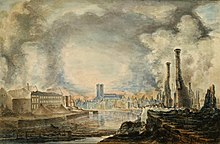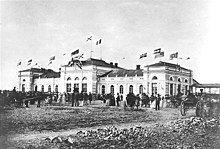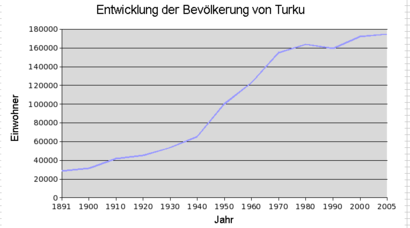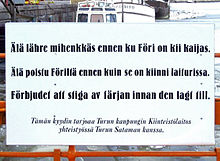Turku
![]()
This article is about the city. For other meanings, see Turku (disambiguation).
Turku [![]()
![]() ˈturku], Swedish Åbo [
ˈturku], Swedish Åbo [![]()
![]() ˈoːbu], is a city on the southwest coast of Finland. From its foundation in the 13th century until the 19th century, Turku was the most important city in Finland. Today, with a population of 194,391 (as of 31 December 2020), Turku is the sixth largest city and the centre of the third largest metropolitan area in the country. It is the seat of the Turku Archdiocese of the Evangelical Lutheran Church of Finland, the Åbo Akademi and the University of Turku. 5.2% of Turku's inhabitants are Swedish-speaking, officially the city is bilingual.
ˈoːbu], is a city on the southwest coast of Finland. From its foundation in the 13th century until the 19th century, Turku was the most important city in Finland. Today, with a population of 194,391 (as of 31 December 2020), Turku is the sixth largest city and the centre of the third largest metropolitan area in the country. It is the seat of the Turku Archdiocese of the Evangelical Lutheran Church of Finland, the Åbo Akademi and the University of Turku. 5.2% of Turku's inhabitants are Swedish-speaking, officially the city is bilingual.
History
History and foundation
The area of today's Turku was inhabited as early as the Stone Age, as archaeological finds from the districts of Kärsämäki and Jäkärlä prove. During the Iron Age, agriculture and trade were practiced in the Aurajoki river valley. This is evidenced, among other things, by graves from the Vendel period found near Lieto Old Castle and in the Kurala district. The Varsinais-Suomi region, in which Turku is located, came under Swedish rule in 1154 during King Erik IX's crusade. The first bishop's see in Finland was Nousiainen.
During the 13th century Turku developed into the first city in Finland. According to a generally accepted theory, the name Turku derives from the Old Russian word tǔrgǔ meaning "market place". The Swedish name Åbo means something like "residence (Swedish bo) by the river (Swedish å)". The year of the town's foundation is traditionally considered to be 1229, but this is based on a misinterpretation of medieval documents. In 1229, Pope Gregory IX approved the transfer of the bishop's seat, apparently from Nousiainen to Koroinen. The village of Koroinen, now a district of Turku, was located a few kilometres upriver. There is no evidence that the actual city of Turku already existed at that time. Therefore, the foundation of the city is more likely to date to the end of the 13th century. When the level of the Aurajoki River became lower due to land uplift, merchants could no longer sail their ships as far as Koroinen and the trading centre was moved to Turku. There is no founding document in which Turku was granted city rights. Nevertheless, it can be considered certain that Turku is the oldest city in Finland, because the next oldest city, Porvoo, was demonstrably founded only in 1346.
Swedish rule
Already in the late 13th century there was a Dominican monastery and a bishop's see in Turku. Turku Cathedral was consecrated in 1300. However, it is unclear to what extent the present church, built of stone and brick, dates back to the construction of that time; according to some researchers, the first cathedral may have been built of wood. Construction of Turku Castle, which was located outside the city, may have begun as early as the end of the 13th century. The castle, the monastery and the cathedral, including the bishop's seat, made Turku the most important city in medieval Finland, along with Viborg. Throughout the period of Swedish rule it remained the political, spiritual and cultural centre of Finland. In the Middle Ages Turku maintained active trade relations with the Hanseatic League, although it was not a member of it. In particular, the lively trade with the Hanseatic cities of Reval (Estonian: Tallinn), Gdansk and Lübeck made Turku the largest trading centre in Finland.
Turku was subjected to attacks several times during the Swedish period. In 1318 the city was drawn into the disputes between the Swedes and Novgorod. The Russians sacked the cathedral and burned down the city. During the final phase of the Kalmar Union, Turku was drawn into the Swedish-Danish power struggles: in 1509, the Danes under Otte Rud invaded Turku, burned the city and looted much of the cathedral treasury. In 1523, Gustav I Wasa conquered the city, after a fruitless siege of the castle a year earlier. Shortly after he was crowned Swedish king, he initiated the Reformation in his country. Martin Skytte, bishop of Turku 1528-1550, was a moderate supporter of the Reformation. He was succeeded by Mikael Agricola, Finland's most important reformer, who had been a student of Martin Luther in Wittenberg and laid the foundation for the Finnish written language with his Bible translation of 1548.
In 1556 Gustav Wasa appointed his son John III as Duke of Finland. John and his wife Catherine Jagiellonica resided in Turku and introduced the splendid court life of the Renaissance period at the castle. After Gustav Wasa's death, there was a power struggle between his sons: in 1563 King Erik XIV had Turku conquered and his brother taken into captivity in Sweden.
The reign of Gustav II Adolf (1611-1632) and his daughter Christina I (1632-1654) was a time of progress for Turku. The provincial administration was established in 1617, the court in 1623. A grammar school followed in 1630. In 1637 Per Brahe the Younger was appointed Governor General of Finland and moved into Turku Castle. He founded the Turku Academy, Finland's first university, in 1640.
In the 18th century Turku, like the rest of Finland, was twice under Russian occupation: 1714-1721 during the Great Northern War and 1741-1743 during the Swedish-Russian War. In the second half of the century, Sweden's mercantilist economic policy led to the establishment of numerous manufactories in Turku. The shipyard, founded in 1732, became an important economic factor in the city over time. At this time, Turku's citizens were divided into three classes: The Swedish bourgeoisie, the Finnish bourgeoisie and the craftsmen. Meanwhile, the population increased to 8,504 by 1791, and by 1805 it had reached 11,300.
Russian rule
During the Russo-Swedish War, Russian troops captured Turku without a fight in 1808. When Sweden had to cede Finland to Russia in the Treaty of Fredrikshamn in 1809, Turku was initially chosen as the capital of the newly created Grand Duchy of Finland. From the point of view of Tsar Alexander I, however, Turku was too far away from Saint Petersburg, which is why the decision was made in 1812 to move the capital to Helsinki, which was insignificant until then. After Helsinki had been developed into a representative capital under the aegis of the architect Carl Ludwig Engel, the transfer took place in 1819. Helsinki's importance was finally consolidated when Turku was almost completely destroyed in the great city fire of 1827. The devastating conflagration destroyed three quarters of Turku's houses within one day. As a result of the fire, Turku Academy, as well as the other institutions that remained in Turku, was moved to Helsinki in 1828 and became the University of Helsinki. Thus Turku had finally lost its dominant position in Finland. Carl Ludwig Engel was commissioned to rebuild Turku. He designed a checkerboard-shaped, fireproof ground plan. Turku remained Finland's largest city for another twenty years until it was overtaken by Helsinki.
Towards the middle of the 19th century, Turku, with its large manufactories, was the most important craft town in Finland, along with Helsinki. However, Turku did not experience the industrial revolution until around 1900. The First World War had positive consequences for the city's industry, as export problems mainly affected the timber industry, which did not play a role in Turku. On the other hand, Turku's location made it easy for it to import raw materials from neutral Sweden.
After gaining independence
After Finland gained independence in 1917, the capital remained in Helsinki. Social unrest had already broken out in Turku by the end of 1917, with socialist "Reds" looting shops. In the Finnish Civil War that followed, the Red Guards took control of the city in late January 1918 and held it until April 12, when German troops fighting on the side of the bourgeois Whites invaded Turku.
In 1918 Turku got a university again after 90 years, the Swedish-language Åbo Akademi. Two years later, the Finnish-language University of Turku was founded. During the Winter War and the Continuation War, various Soviet air raids were carried out on the city, causing a total of 52 civilian deaths; in addition, 1.8% of the housing was destroyed and 3.3% severely damaged.
In the knife attack in Turku on August 18, 2017, a Moroccan man whose asylum application was not approved killed two people and injured six others.

The great city fire of 1827. lithograph by C. A. af Scheele

Opening of Turku railway station in 1876
.png)
Map of Turku around 1920

Turku Cathedral before its destruction by the city fire. Watercolour by Carl Ludwig Engel from 1814.
Population
At the end of 2005, the population of Turku was 174,906. Turku is the sixth largest city in Finland after Helsinki, Espoo, Tampere, Vantaa and Oulu. Espoo and Vantaa, however, are effectively suburbs of Helsinki. The Turku metropolitan area is the third largest metropolitan area in the country after the Helsinki region and the Tampere metropolitan area.
Self-image
The people of Turku have a strong regional self-confidence, not least because of their city's past. There is a saying in Turku that you can't become a Turku person, you can only be born a Turku person. Above all, the local dialect (Turun murre) is identity-forming. Dialect poetry and comics are also published in the Southwest Finnish dialect.
The city of Helsinki, which does not have such a long history and only became the capital in the 19th century, is seen as an "upstart" by many Turku residents. However, the rivalry with Tampere, which overtook Turku as Finland's second largest city in the 1960s, is particularly pronounced.
Populations
Traditionally, Turku had a large Finnish-Swedish population. Around 1870, half of Turku's inhabitants spoke Swedish as their mother tongue. Over time, however, many Finnish-Swedes adopted the Finnish language. In addition, immigration to Turku was mainly from Finnish-speaking areas, so the proportion of the population speaking Swedish decreased constantly. At the turn of the century it was only a quarter, in 1950 a tenth. Today, 5.2% of Turku's population is Swedish-speaking. Although in Turku the percentage is below the 6% threshold stipulated in the Finnish Language Act, due to the numerical size of the Swedish-speaking minority (9000 people), the city is officially bilingual with Finnish as the majority language and Swedish as the minority language. Therefore, for example, all streets have a Finnish and a Swedish name.
4.2% of Turku's inhabitants are foreigners, mainly from Russia, Estonia, Iraq and Iran. This is a high proportion of foreigners by Finnish standards. The increasing number of immigrants, especially in the eastern suburbs of the city, has partly led to xenophobia, which is reflected in the relative electoral successes of the nationalist party Suomen Kansan Sinivalkoiset (Blue-White Front). While throughout Finland this far-right party never received more than 0.1% of the vote, in Turku, the hometown of its party leader Olavi Mäenpää, it was able to place a city councilor in 2004 with 3.9% of the vote. The latter was also active in the successor organisations. He was sentenced to seven months in prison for fraud in 2017 and died in 2018, but in the 2015 general election the right-wing populist True Finns party fell short of the Finnish national average of 17.7%, with 16.2% in Turku.
Religions
The vast majority of Turku's population belongs to the Evangelical Lutheran Church. Turku Cathedral is the seat of the Archbishop of Turku, the head of the Evangelical Lutheran Church of Finland. The Archdiocese of Turku includes the Finnish-speaking parishes of Varsinais-Suomi and Satakunta.
There is also an Orthodox parish in Turku. Its main church is the Empress Alexandra Martyrs' Church, which is representatively located in the central market square. The rotunda is modelled on the Pantheon in Rome and was completed in 1845 according to plans by Carl Ludwig Engel.
There is also a small Catholic parish in Turku, the parish of St. Birgitta and Blessed Hemming. The church of Turku was built in 1966 and is located in the centre of the city. The Catholic community has grown especially due to the immigration of Asian and Polish immigrants. In addition to the Catholic community, the Order of the Birgittes, a Catholic convent, has also settled in Turku.
Since the 19th century, Turku has been home to a small group of Muslim Tatars, with recent arrivals of Muslim immigrants. The Jewish community of Turku has about 120 members. Turku's synagogue is the only one in Finland, along with the one in Helsinki.
From Turku, the Christmas Truce is proclaimed for the whole of Finland every year at 12 noon on 24 December.
Population development
The population of Turku increased steadily until around 1970. This was followed by a period of slight decline, until the population began to rise again from 1990.
|
|

Development of the number of inhabitants from 1891 to 2005

Trilingual sign at the ferry across the Aurajoki: Turku dialect, Finnish and Swedish
Search within the encyclopedia